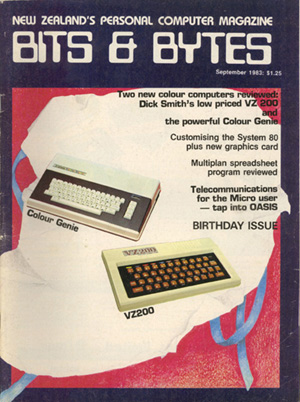| Tweet |
Eaca Colour Genie Auckland User Group Newsletters March 1984 to March 1986
Introduction
In the early-mid 1980s, home computers were represented by a bewildering array of makes and models. Although most had some variant of Microsoft BASIC built-in, there was no standardization as such. This meant that software, and disk/tape file formats, were specific to the machine. To port it to other models meant typing a program in from scratch, or recompiling it for the new platform making allowances for different hardware. Modifications to said hardware were also specific to the model. These differences, and the fact that home computing was a novel concept and not at all intuitive, meant user support was important. That support came not so much from the manufacturer, but other sources such as magazines, books and local user groups.
The importance of user groups to orphan computers
Local user groups were clubs or associations centered in towns, cities or areas that grew up around particular microcomputers. While part of a wider support landscape for popular machines, they were critical for "orphan" computers. The latter were machines that appeared in the market, failed to become popular and then in a very short time were either abandoned by their manufacture or the company folded.

Figure 1. The Eaca Colour Genie on the cover of New Zealand Bits and Bytes, September 1983
The EACA Colour Genie is one such machine. It appeared on New Zealand shelves around the middle of 1983, but by the end of that year EACA was out of business . Distributors still had stock, which they gradually sold off, but Colour Genie users were on their own. Despite this, or perhaps because of it, small but active user group communities sprung up in New Zealand, the U.K., Germany, The Netherlands and possibly other countries.
The Colour Genie Auckland District User Groups (and why I scanned their newsletter)
I acquired a bundle of newsletters of the Colour Genie Auckland District User Group with one of my Colour Genies. For computer historians, user group newsletters provide a glimpse into the role these associations played in supporting "orphan machines", and their contribution to early personal computing generally. This is why I decided to scan the Colour Genie user group newsletter issues I had, and make them available on this page. The contents cover activities such as...
- Making software available both as listings and on cassette tape
- Demos, talks and "how to" articles on all kinds of topics
- Liaison with other New Zealand and international user groups for access to software and hardware
- Building a community

Figure 2. Typeface at the top of each newssheet
There are 24 issues available covering the two years from March 1984 to March 1986. I have the first one, but I suspect not the last. The collection seems to be rough photocopies, however it is possible that they were originally produced like this. Most of the content is program listings, but there are some articles and considerable comment by editor Nola Huggins. Nola played a major role in the group. She had an indomitable and direct writing style, which adds an authenticity to the text. The tone is generally one of excitement, curiosity and activity, but also increasing frustration as support and overseas contacts start to dry up.
Reading these newsletters today, the Auckland Colour Genie user group appears quaint and nostalgic, a relic of a bygone era. It reflects the typical club culture of the time though.
(i) Individual issues
- Auckland District Colour Genie User Group Newsheet First one (incomplete)
- Auckland District Colour Genie User Group Newsheet, March, 1984
- Auckland District Colour Genie User Group Newsheet, April, 1984
- Auckland District Colour Genie User Group Newsheet, May, 1984
- Auckland District Colour Genie User Group Newsheet, June, 1984
- Auckland District Colour Genie User Group Newsheet, July, 1984
- Auckland District Colour Genie User Group Newsheet, August, 1984
- Auckland District Colour Genie User Group Newsheet, September, 1984
- Auckland District Colour Genie User Group Newsheet, October, 1984
- Auckland District Colour Genie User Group Newsheet, November, 1984
- Auckland District Colour Genie User Group Newsheet, December, 1984
- Auckland District Colour Genie User Group Newsheet, February, 1985
- Auckland District Colour Genie User Group Newsheet, March, 1985
- Auckland District Colour Genie User Group Newsheet, April (1), 1985
- Auckland District Colour Genie User Group Newsheet, April (2), 1985
- Auckland District Colour Genie User Group Newsheet, May, 1985
- Auckland District Colour Genie User Group Newsheet, June, 1985
- Auckland District Colour Genie User Group Newsheet, July, 1985
- Auckland District Colour Genie User Group Newsheet, August, 1985
- Auckland District Colour Genie User Group Newsheet, September, 1985
- Auckland District Colour Genie User Group Newsheet, October, 1985
- Auckland District Colour Genie User Group Newsheet, November, 1985
- Auckland District Colour Genie User Group Newsheet, December, 1985
- Auckland District Colour Genie User Group Newsheet, February, 1986
- Auckland District Colour Genie User Group Newsheet, March, 1986
(ii) All of them
- in a Zip file! (17.8 MB)

Figure 3. My own Colour Genie
Enjoy!
Tez
18th March, 2017
| Tweet |